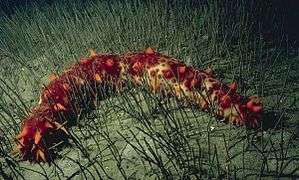California sea cucumber
| California sea cucumber | |
|---|---|
 | |
| Scientific classification | |
| Kingdom: | Animalia |
| Phylum: | Echinodermata |
| Class: | Holothuroidea |
| Order: | Synallactida |
| Family: | Stichopodidae |
| Genus: | Apostichopus |
| Species: | A. californicus |
| Binomial name | |
| Apostichopus californicus (Stimpson, 1857) | |
| Synonyms | |
| |
The California sea cucumber (Apostichopus californicus),[2] also known as the giant California sea cucumber, is a sea cucumber that can be found from the Gulf of Alaska to Baja California. It is found from the low intertidal zone to a depth of 250 m (820 ft). They are most abundant in areas with moderate current with cobbles, boulders or bedrock.
Description
The California sea cucumber can grow to a length of 50 cm (1 ft 8 in) and a width of 5 cm (2 in). It has a soft, cylindrical body, with red-brown to yellowish leathery skin. It has an endoskeleton just below the skin. The mouth and anus are on opposite ends of the body. The mouth is surrounded by twenty retractable tentacles that are used to bring food in. Five rows of tube feet extend from the mouth to the anus. Mobility is limited, though individuals can move up to 4 m (13 ft) per day while feeding. They use their tube feet located on the underside of their body.
Feeding
.jpg)
The California sea cucumber is a scavenger that feeds on plankton and other organic matter. They feed by sifting through sediments with their tentacles, or by positioning themselves in a current where they can use their tentacles to catch food flowing by.
Behavior and reproduction
A. californianus is a solitary nocturnal animal. It has the ability to regenerate all parts of its body. When threatened, it can expel all its stomach contents through its anus until its next feed. It can also expel sticky filaments to ensnare or confuse predators. It undertakes seasonal migrations to different depths.
These sea cucumbers have separate sexes, and eggs are fertilized externally. Spawning usually takes place in August, and each female can produce thousands of eggs. After fertilization, a larva is formed which metamorphoses into a sea cucumber after a few weeks.
References
- ↑ NatureServe (2013). "Parastichopus californicus". IUCN Red List of Threatened Species. Version 2014.3. International Union for Conservation of Nature. Retrieved 15 December 2014.
- ↑ G. Paulay (2010). "Apostichopus californicus (Stimpson, 1857)". World Register of Marine Species. Retrieved September 29, 2017.
- Benton, William, et al. Britannica Macropaedia. Chicago: Encyclopædia Britannica, Inc, 1976.
- Stichpus californicus. NWMarineLife.com, Olympia, Washington.
| Wikimedia Commons has media related to Parastichopus californicus. |
